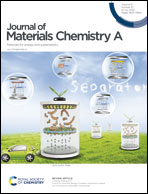Liquid-phase synthesis of the Li10GeP2S12-type phase in the Li–Si–P–S–Cl system†
Abstract
The Li10GeP2S12-type phase in the Li–Si–P–S–Cl system (LSiPSCl) shows the highest lithium ionic conductivity among the Li ion conductors reported to date. With the aim of establishing a large-scale production process for LSiPSCl, we report the development of a liquid-phase approach to its synthesis. The ionic conductivity and particle morphology are characterised, and their effects on the electrochemical properties of the LSiPSCl phase synthesised by the new liquid-phase method (L-LSiPSCl) are investigated. An L-LSiPSCl phase with an ionic conductivity of 6.6 mS cm−1 at 298 K is obtained by adjusting the sulfur ratio in the dissolved starting materials. Compared with the LSiPSCl phase synthesised via the conventional solid-state approach (S-LSiPSCl), L-LSiPSCl shows an increased grain-boundary resistivity and its particles consisted of small porous grains. An all-solid-state cell prepared using L-LSiPSCl as the solid electrolyte exhibits stable cycling, with a discharge capacity retention of >97% after 100 cycles; this is a comparable performance to that of the S-LSiPSCl-based reference cell, indicating that L-LSiPSCl functions stably as a solid electrolyte in all-solid-state batteries. Finally, this study suggests that liquid-phase synthesis is a promising approach for the large-scale production of sulfides that exhibit high ionic conductivities, such as LSiPSCl.



 Please wait while we load your content...
Please wait while we load your content...